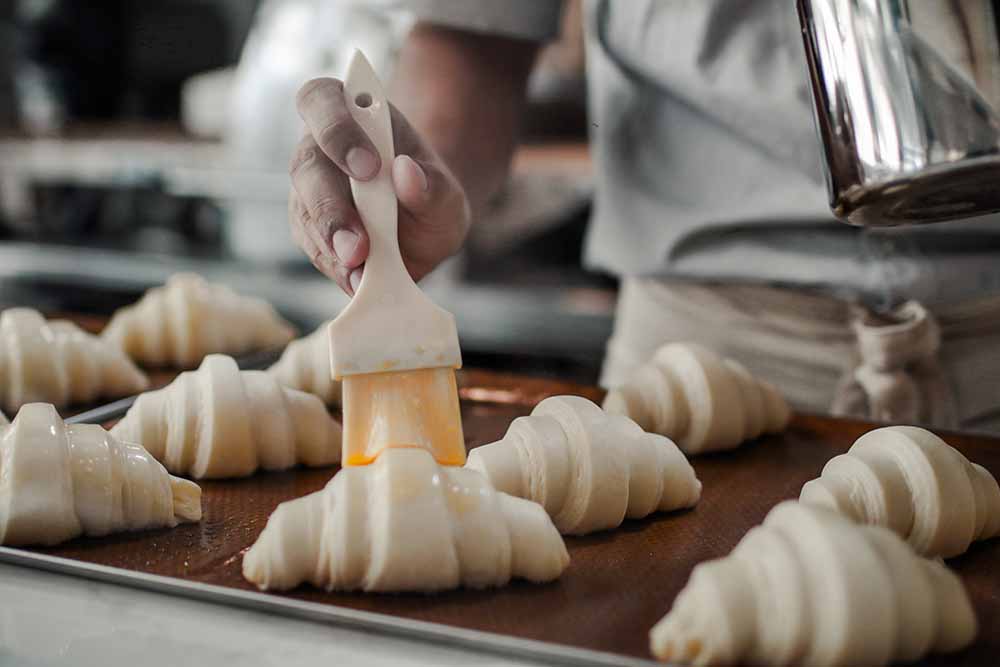Croissants, a beloved French pastry, are famous for their flaky, buttery layers and delightful taste. The origin of croissants can be traced back to Austria, but they became synonymous with French cuisine. Making croissants from scratch might seem daunting, but with the right techniques and patience, you can achieve bakery-quality results at home. In this blog, we will walk you through each step of the process, so you can savour the joy of baking your own perfect croissants.
Ingredients
To make the perfect croissants, you'll need a few simple yet essential ingredients. The primary ingredients are all-purpose flour, unsalted butter, water, milk, sugar, yeast and salt. The butter should be of high quality, as it significantly impacts the taste and texture of the croissants. Additionally, you can enhance the flavour by adding a touch of vanilla extract. While these ingredients form the base, feel free to experiment with fillings like chocolate, almond paste or ham and cheese, depending on your preferences.

Tools Required for Making a Croissant
Before embarking on your croissant-making journey, gather the necessary tools to ensure a smooth baking process. You will need a rolling pin, pastry brush, kitchen scale, ruler and baking sheets. A stand mixer or a mixing bowl with a wooden spoon is essential for kneading the dough. For precise cutting and shaping, keep a sharp knife or a pizza cutter on hand. With these tools at your disposal, you'll be all set to create picture-perfect croissants.
Preparing the Dough
The foundation of a fantastic croissant lies in the dough. Begin by mixing the dry ingredients together, including flour, sugar, salt and yeast. Warm the milk and water to a specific temperature, and then add it to the dry mixture. Knead the dough until it becomes smooth and elastic. Let it rest and rise until doubled in size.
Next comes the butter block, which is a crucial step in achieving those flaky layers. Roll out a block of cold butter between parchment paper and chill it until firm. Once the dough and butter are ready, it's time to encase the butter within the dough in a process known as "locking in the butter." Roll out the dough, place the butter block in the center, and fold the dough over it.
Laminating the Dough
Lamination is the process of creating alternating layers of dough and butter, which is key to the croissant's signature flakiness. Roll the dough-butter packet into a long rectangle and perform a series of folds, known as ’turns,’ to create layers. Chill the dough between turns to keep the butter from melting.
The number of turns you perform will determine the final flakiness of your croissants. Generally, three to four turns are sufficient, but more turns will result in a more delicate texture. Always keep the dough and butter cold during this process, as this is what ensures the layers will form beautifully.
Shaping the Croissants
After the dough has been properly laminated, it's time to shape your croissants. Roll out the dough into a large triangle and cut smaller triangles from it. Gently stretch each triangle to elongate it slightly. Starting from the wide base, roll up each triangle tightly towards the tip, creating the classic croissant shape.
Place the shaped croissants on a baking sheet, leaving enough space between them to expand during baking. Allow the croissants to proof until they double in size. Before baking, brush them with an egg wash for a shiny, golden finish.
Tips and Additional Considerations
- Always use good quality butter and flour for the best results.
- Maintain a cold environment while working with the dough to prevent the butter from melting.
- Don't rush the lamination process; it requires patience and precision.
- Experiment with different fillings to create unique croissant flavours.
- Avoid overproofing the croissants, as this can affect their texture.

Conclusion
Making croissants from scratch is a rewarding experience that allows you to enjoy the delectable taste and aroma of homemade pastries. With a bit of practice and the right techniques, you can achieve flaky, buttery perfection that rivals any bakery. So, roll up your sleeves, follow our guide, and indulge in the sheer joy of baking your own perfect croissants.
FAQs
Can I use margarine instead of butter for croissants?
While it is possible to use margarine, the flavour and texture of the croissants might not be as rich and flaky as those made with butter.
How long do homemade croissants stay fresh?
Homemade croissants are best enjoyed on the day they are baked. If you have leftovers, store them in an airtight container for up to 2-3 days, and reheat them in the oven before serving.
Can I freeze croissant dough for later use?
Yes, you can freeze croissant dough after shaping but before proofing. Wrap it tightly in plastic wrap and store it in the freezer for up to a month. When ready to bake, thaw the dough in the refrigerator overnight, then proceed with proofing and baking.